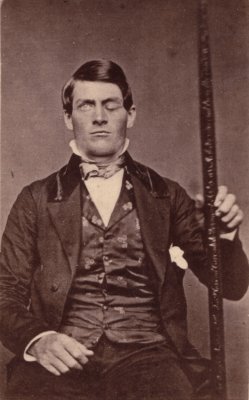- Joined
- Jul 19, 2004
- Messages
- 29,622
- Location
- Out of Bounds
I searched, but didn't find any thread that recommended itself for this ...
Although images / illustrations of Gage's skull damage are not rare, there were no known photos of him after his famous accident.
Such a photo has apparently surfaced ....
The photo, his life mask, and skull are illustrated in this news article at NPR.org.
Although images / illustrations of Gage's skull damage are not rare, there were no known photos of him after his famous accident.
Such a photo has apparently surfaced ....
The photo, his life mask, and skull are illustrated in this news article at NPR.org.
January 24, 2010
In 1848, Phineas Gage became a medical miracle.
Gage was a 25-year-old railroad foreman, who was known for being efficient and friendly. One September day, his crew was laying track in Cavendish, Vt. As he was tamping explosive powder into a hole in the rock, the powder exploded prematurely, driving the tamping iron straight through his head.
Gage never lost consciousness. He sat upright in the ox cart that carried him to an inn, a half-mile away. He was met there by Dr. John Martyn Harlow, who performed one of the first neurosurgeries ever. Gage recovered in a matter of months, though he lost his left eye.
That tamping iron now hangs in the Warren Anatomical Museum at Harvard Medical School. Most visitors to the museum come to see the giant spike and a life mask of Gage's head, complete with gaping scar.
"I talk about Gage all the time," curator Dominic Hall tells NPR's Guy Raz.
"It's funny — I have this close relationship to Phineas Gage because of how often I look at his case, and think about his case, and talk about his case with other people," Hall says.
Gage and his remarkable story of survival have become the stuff of medical legend. But photos of him were lost to history — until now.
That's Not A Harpoon
In 1968, Jack and Beverly Wilgus were charmed by a daguerreotype of a man holding a metal rod. It showed a seemingly self-possessed young man, surprisingly handsome despite missing an eye.
"It has a real presence about it," Jack says.
The Wilguses thought the man must have been some kind of whaler. They titled the portrait "One Eyed Man with Harpoon" when they posted it on their Flickr account over a year ago.
Whaling experts soon debunked that theory. That's not a harpoon, they said, and that's no whaler. The mystery remained until another Flickr member, Michael Spurlock, noticed the image. "Maybe you found a photo of Phineas Gage?" his comment read.
"The first thing I did, of course, was to Google Phineas Gage," Beverly says. "The more I read, the more excited I got, because everything just fit."
Harvard hasn't officially confirmed the daguerreotype's authenticity, but Hall is confident the man in the image is Gage. He says there are several points of correlation, including an inscription on the tamping iron that matches the one hanging in the museum.
The Wilguses are already convinced.
"Knowing it's Phineas Gage and not just [an] anonymous person has certainly changed the way I feel about it," Jack says.
"It's like getting to know a lost relative or something. You've lived with this person, at least the image of them, for all these years," he says. "We’ve literally looked at that daguerreotype every day during the time we've had it, because it's always been on display."
...
The confident attitude of the man in the picture is a revelation to his biographer, Malcolm Macmillan. Macmillan, a professor at the University of Melbourne in Australia, says the image most people have in their minds of Gage is surly and downtrodden.
That's because it was Gage's subsequent personality shift, more than the groundbreaking surgery, that vaulted him into medical journals and psychology classes. He literally became the textbook example of brain trauma's effects on personality.
After the accident, Gage withdrew. He was frequently described as childlike, vulgar and coarse, in contrast to the pleasant, businesslike manner he once had. He lost his job with the railroad and became a stable hand in New Hampshire for a while before driving coaches in Chile. He died in 1860 in California at the age of 36 after a series of convulsions.
The Wilguses' daguerreotype, however, may change how people see Gage. "Before, when you're thinking of Gage, you think of a skull, or you think of a life cast, or you think of an iron," Hall says. "But now, there's this image."
"This is the image that now I can associate with Gage," Hall says. "It's become a new dimension in my relationship with this individual."
http://www.npr.org/templates/story/stor ... t=1&f=1007



